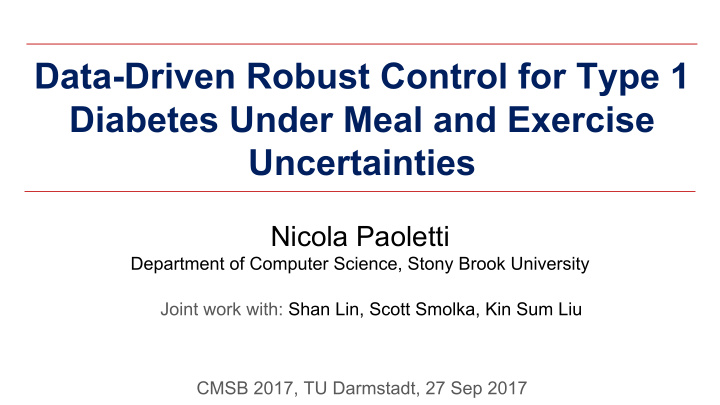



Data-Driven Robust Control for Type 1 Diabetes Under Meal and Exercise Uncertainties Nicola Paoletti Department of Computer Science, Stony Brook University Joint work with: Shan Lin, Scott Smolka, Kin Sum Liu CMSB 2017, TU Darmstadt, 27 Sep 2017
Diabetes WHO Global report on diabetes, 2016
Type 1 Diabetes (T1D) T1D HYPERGLYCEMIA Blood glucose Healthy SAFE RANGE HYPOGLYCEMIA Time Meal
T1D therapy, devices Insulin pump delivers two kinds of insulin: - Bolus : high, on-demand dose to cover meals - Basal: to cover demand outside meals Continuous Glucose Monitor (CGM) detects sugars levels under the skin, a Image from: https://www.medtronic- measure of blood glucose (BG) diabetes.com.au/pump-therapy/what-is-insulin-pump- therapy
T1D therapy – limitations CGM - Pump and CGM don’t communicate with each other PUMP - Bolus is manually set by the patient → danger of wrong dosing
Closed-loop control = Artificial Pancreas (AP) Sugar levels Challenges CGM à CGM is a “derived” measure of BG (noisy and delayed) PUMP Glucose/ à Disturbances related to patient Insulin metabolism behavior (Meals and Exercise) NOT JUST MEDICAL BUT ALSO AN ENGINEERING CHALLENGE
Closed-loop control, aka Artificial Pancreas (AP) Sugar levels CGM PUMP Glucose/ Insulin - Only controls basal insulin metabolism - Meals are still announced NOT JUST MEDICAL BUT ALSO AN ENGINEERING CHALLENGE
Artificial Pancreas, a control problem Our solution: T1D T1D + A data-driven robust model predictive control Blood glucose therapy (MPC) design for the AP: Healthy - Closed-loop control of both basal and bolus insulin - Handles uncertainty by learning from data Insulin - Accurate state estimation from CGM measurements
System Overview
Data-driven uncertainty sets - Learn from data uncertainty sets that capture realizations of uncertainty parameters (meal and exercise) - Method that provides uncertainty sets with probabilistic guarantees [Bertsimas et al., Mathematical Programming (2013): 1-58 ] : Uncertainty Sets Meal/exercise data (questionnaires, surveys, sensors, …) (mmol/min) Carbs Time (min)
Robust Model Predictive Control Find the insulin therapy at time t, t+1,... that minimizes the worst case performance w.r.t. uncertainty parameters Objective function: combination of distance from target trajectory and step- wise discrepancy of control strategy
State Estimation We designed a Moving Horizon Estimator (MHE) : - “Estimation a la MPC”: uses a model to minimize distance between predicted and actual measurements, and between predicted and estimated states over a moving window of length N - It works also as a meal estimator: estimates the most-likely uncertainty parameter values Rao et al., IEEE Trans. Automatic Control 48 (2), 246-258, 2003
Evaluation Robust controller compared with - Perfect controller: with exact knowledge of uncertainty parameters and full state observability (no state estimation errors) - “Hybrid closed-loop” controller: considers only glucose measurements and not patient behavior
Virtual patient learnt from NHANES database GROUP 1: Carbs-rich breakfast - We learn patient models from CDC’s NHANES Carbs (mmol/min) - Meal data from 8,611 participants - We cluster data into 10 main groups (finer classification is possible) Time (min) T hypo T in range T hyper Perfect 0% 100% 0% 18.5 % 80.97 % 0.53 % Hybrid closed- loop 2.02 % Robust 93.45% 4.52%
Scenario 1 - Meals as expected Carbs (mmol/min) Situation where uncertainty set (gray box) is accurate T hypo T in range T hyper BG (mmol/L) Perfect 0% 99.69% 0.31% Hybrid closed- 1.6% 69.4% 29% loop Robust 0.51% 97.7% 1.79%
Scenario 2 - Unexpected delays in meals Carbs (mmol/min) Situation where uncertainty set is NOT accurate T hypo T in range T hyper BG (mmol/L) Perfect 0% 100% 0% Hybrid closed- 0% 67.25% 32.75% loop Robust 0.79% 99.03% 0.18%
Scenario 3 – High carbs intake, 2 days Typical settings to test robust AP controllers T hypo T in range T hyper BG (mmol/L) Perfect 0% 99.52% 0.48% 1.55 % 80.6 % 17.85 % Hybrid closed- loop 3.11% Robust 87.56% 9.33%
Summary - Robust controller design for insulin therapy that well supports meal disturbances. - Based on deriving uncertainty sets from patient data. - Evaluated on synthetic scenarios and real data. - Towards fully closed-loop diabetes therapy and smart medical devices. Future work - More advanced patient behavioral model. - “Human-in-the-loop”: interplay between insulin control and recommendations.
Recommend
More recommend